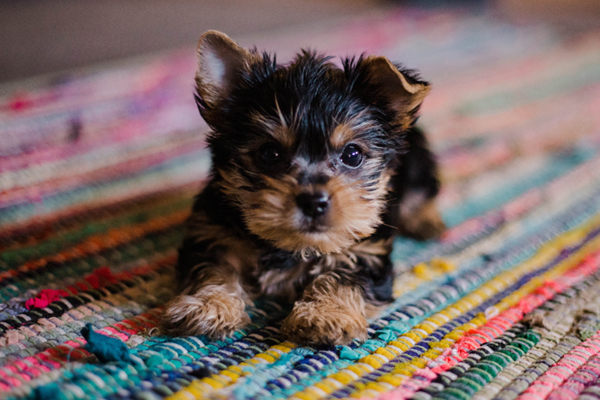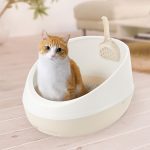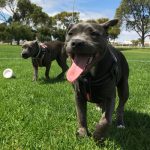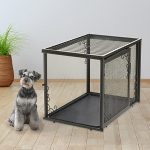
Congratulations! If you are reading this blog article then you are likely a proud pet parent of a new puppy or you know someone who is. Housetraining, aka potty training, is the cornerstone to a happy and rewarding bond between a dog and its owner.
To be sure, housetraining can take a little time, so the more patient, committed, and consistent you are with the process, the more pleasant and successful the experience will be for all involved. When combined with positive encouragement in the form of praise and/or healthy treats, a puppy will typically learn proper elimination habits within a few weeks to a few months and shortly thereafter will be completely house trained.
There are three courses of action for potty training your new canine arrival: Train your pooch to eliminate outside (housetraining), train him to first use a Potty Pad and then make the transition to the great outdoors, or train him to use a potty pad full time. Housetraining 101 will lay out all the options and best practices for potty training a new dog. Just remember that accidents do happen and are part of the process, but the sooner these tips can be implemented the sooner man’s best friend will get on track and become a trusted and committed companion.
When to Begin Potty Training
Potty training should begin as soon as a puppy or adult dog is brought home, but in the case of a puppy, not a lot of progress should be expected until he is 12 to 16 weeks old. This is because puppies typically don’t have enough bladder and bowel control until this time. If your puppy or adult dog has already been going potty in a cage or enclosed space before arriving at your home, it will take some additional time, patience, and encouragement to reform the dog’s habits if the desire is to have him completely house trained.
Potty Pad Training
Potty training by utilizing potty pads can be helpful for many people in various situations, including those who work away from home all day and don’t have help, upper floor apartment or condo dwellers, people with a handicap, owners of small dogs in northern, very cold climates and for older dogs who might be handicapped or incapacitated. Potty pad training is also helpful for pet parents who want to gradually transition their pet from eliminating inside to instead going outside after a while. Richell has a great PAW TRAX Potty Pad Holder that greatly aids with these scenarios.
A good way to begin potty pad training is to identify the confined area of your home in which you wish to place the potty pad and tray. This could be a bathroom, laundry room, or any tucked-away place with hard, cleanable floors. To attract your puppy or adult dog to the potty pad, place some of his business or some of a previously soiled pad in the center so he knows where to go. If you feel your pup may have trouble finding the right spot initially and you want to avoid a mess, you may want to line the entire area between his bed and the potty pad holder with potty pads and then remove ones that aren’t used as he finds his mark.
Crate Training
Another good option for potty training is the crate method. This method is good if a pet owner has no intention of letting their dog soil in the home and wants all elimination to take place outside. To many first-time pet owners, the thought of confining a dog to a crate seems cruel, but when they think more about why a dog naturally craves a “cave-like ” or cozy environment at times, they begin to think about crates in a different light.
Dogs are often referred to as den animals, but they don’t live in dens year-round or burrow into the ground like groundhogs or gophers. However, they are born and raised for the first 8-12 weeks in a maternal den away from predators where they can keep tucked in, warm, and fed by their mother. A dog crate can mimic a puppies’ maternal den as well as being a great confinement area so their whereabouts are always known. In the end, dog crates can make life much simpler and less messy when housetraining. Besides potty training, there are many reasons to get your dog used to a crate. Good examples include confinement for safety, knowing where your puppy is at all times, guest arrivals, travel, vet visits, injury rehab, and “time out” periods.
To effectively crate train a puppy or adult dog, the crate should only be big enough for the dog to stand up in and turn around. If more room than that is provided, the dog may feel there is enough room to potty in one corner and live in the other. One major point of crate training is to eliminate the desire for the pet to eliminate in the crate. Many crates come with adjustable partitions so the crate can be made smaller when needed. If your pooch is eliminating in the crate, then the crate area needs to be smaller, or they may not be going outside often enough. If they were purchased from a pet store or shelter they may have brought bad habits along with them. Additional work will be needed to stop the behavior.
A Routine Matter
Establishing a routine with your new puppy is critical. Just like with infants, puppies are much easier to work with when they get into a consistent routine. There is an eating schedule, potty excursions, playtimes, nap, and sleep periods that will need to be worked into their routine.
Puppies can typically hold their bladder one hour for each month they are old. So, a three-month-old puppy should be able to hold his pee for 3 hours. If you go longer than this guideline you risk them having an accident – and you want to avoid as many accidents as possible to build up their confidence. Also remember that the larger the dog breed the larger the bladder, so petite dog breeds will need to go potty more often than large dog breeds on average – both when they are a puppy and an adult.
Going Outside – Taking your new puppy outside at least every one to two hours is a good place to begin. Stick to these intervals until your puppy successfully gets this routine down. You can then gradually increase the intervals the more your pooch succeeds. Be patient. If nothing happens in 10 minutes, go back inside and try again in another 15 minutes.
You will also want to take your pup out first thing in the morning and the last thing at night. Also, you should plan on taking him outside during and after playtime, after he eats and or drinks, after naps, after chewing a bone or toy, and after spending some time in a crate, playpen, or partitioned room.
It is very helpful to teach your puppy a potty word such as “time to go”, “potty time” or “time to potty”, etc. Maybe even teach him to sit on a rug by the door and bark or ring a bell. Just keep in mind that the potty word is just for going to the bathroom and not for going outside to play. Potty time is separate from playtime until the routine becomes established.
A dog’s natural instinct is to go to the bathroom anywhere possible except where they sleep - so your entire house is fair game. That’s why it’s important to stay the course in potty training for both outside and inside if a potty pad scenario is desired.
Accidents Will Happen - When an accident has already occurred inside, use it as a teaching experience instead of a penalty. And be mindful that scolding or yelling at a dog for leaving a mess can lead to a distrust of the person handing down the punishment. Simply wipe up the mess and take it outside and stake or set it in the area in which you want your puppy to eliminate. This is especially helpful if you have previously cleaned up his outside mess or he hasn’t yet done his business outside. This will serve as a marker for the next time he goes potty outside. When he has successfully done his business, you can bring in the mess you had cleaned up from inside. Offering praise or a treat while still outside for a job well done will go a long way in making it a positive and desirable experience for your pooch. Many puppy parents praise too quickly and the puppy gets distracted – thus leading him to finish his business inside. Walking a little further or playing with him a little afterward will reward him for a job well done.
If you happen to catch your puppy “in the act”, and most likely you will, interrupt your puppy by making a startling noise. Not a scary noise, but something a little unusual to get his attention. Take him to his potty spot outside immediately and then praise your pup when he is finished. Don’t punish your puppy for going to the bathroom inside. It’s already too late to penalize him. Just clean up the soiled area completely and consider using a water/vinegar solution or enzymatic cleaner to eliminate the smell and discourage further soiling in that spot. If the spot is on the carpet, be sure to blot the carpet to remove as much liquid as possible before wiping down the spot. Many natural solutions are also available online or at pet stores for getting rid of urine, feces or vomit smells.
Patience will be needed and supervision is key. The more accidents that can be eliminated, the shorter the potty training instruction period. If frustration sets in because accidents keep occurring inside, just be sure not to rub your dog’s nose in it or scold him as mentioned above. This is counterproductive and can lead to him fearing you.
What Goes In Comes Out – Feeding your puppy on a consistent feeding schedule allows for your pup to go to the bathroom on a regular schedule as well. Young puppies should eat three or four times a day since their digestive system is still immature and they can’t handle a bunch of food at once. Better quality food = the better and more consistent their business will be. As a puppy become older, you can start weaning him down to two feedings a day. By feeding your puppy at the same time each day it means they will potty about the same time every day. This makes it much easier for everyone. Just be sure to take away any leftover food between meals. Be sure to pull up your pup’s water bowl about 3 hours before bedtime. This will allow all fluids to be eliminated before it’s time to hit the sack. A puppy should be able to hold his bladder between 6 – 8 hours overnight when you prepare accordingly.
When a puppy does need to go in the middle of the night, be sure to turn on as few lights as possible, keep a low key attitude and tone, tell your new puppy it’s time to go “potty” and go right outside or to his potty pad. Once the exercise is complete, guide him right back to his crate, room, or sleeping area and tell him it’s time to go to sleep. Then turn off all the lights unless a nightlight is being used for comfort. Resist the urge to play with him or cater to any whining or barking after he has been placed back in his crate or sleep area. Have faith that since you just put him out and he likely went potty, that he is ok. The quicker he knows it’s time to go to sleep, the faster he will adjust to your planned routine.
Supervision is Key – Whether your puppy is inside or out, they should always be supervised. Play is fun for all, but playing can’t take place 24/7. When not playing, your pup can stay on a leash with you or be tethered to a piece of furniture. Playpens or gated areas work well also. Watch for indications such as barking, tail up, sniffing around, squatting, circling, or just a sense of restlessness. These are all signs that your puppy may need to go to the bathroom. If you can catch your pup before he eliminates inside, you will progress through housetraining 101 much quicker. Supervision in your yard by utilizing the leash is preferred over granting freedom to roam right away to an inexperienced pup.
No Supervision Available - When you can’t supervise your pet and no help is available, your puppy will need to be confined to a small bathroom, laundry room, mudroom, or a crate where they can lie down, turn around and stand up…but nothing else. Pet Gates can be a great solution for no supervision.
When You’re Away – A puppy needs constant supervision or a confined area in which to remain while you are gone. Arranging for a family member, neighbor, or professional pet sitter to take care of your puppy in your absence would be the best way to handle things while you aren’t home. You can also train them to use potty pads in a designated area where they are confined. Just be sure to remove any mess outside of the potty pad and place it on the potty pad so your pup remembers where he is supposed to go to the bathroom.
How Long Does Potty Training Take?
This question has many answers. It just depends on the breed and how old the puppy is. The younger the puppy the longer it will typically take. On the flip side, the older the puppy the shorter it will usually take. That being said, each breed and dog are different. Some young puppies pick up housetraining in a few days to a week and some older puppies take longer than that. A big part of the equation has to do with the dog owner and how much supervision, instruction, and praise is given. Good supervision and routine go a long way in hastening good potty training results.
Housetraining – Potty Training isn’t as easy as many would like, but it is well worth the effort in the long run. Not only does it make life easier for all, but the sense of satisfaction enjoyed by both dog and owner alike is the cornerstone to building a solid foundation of trust and respect. Potty training isn’t glamorous or typically much enjoyed, but it is essential to the relationship that is being built between man and man’s best friend and will pay dividends for years to come.
#happypuppy
 The Importance of a Clean Litter Box
The Importance of a Clean Litter Box
12.30.2020
Cats are notoriously clean animals. Nature has selected this trait as being supremely beneficial for cats in the wild. Luckily, domestic cats have retained this behavior. >>> READ MORE
 Dog Park 101: Tips for Visiting Your First Off-Leash Dog Park
Dog Park 101: Tips for Visiting Your First Off-Leash Dog Park
12.01.2020
So you’re thinking about visiting an off-leash dog park for the first time. Or perhaps you’ve already been to a dog park and want to see if you got things right... >>> READ MORE
 Why Crate Training is Important
Why Crate Training is Important
10.15.2020
If this piece were instead titled “Why Crate Training isn’t Important”, it would be a much shorter read and one could immediately go about their day. >>> READ MORE
Please complete this form and click "Submit". Our Customer Support team will gladly address your request and respond in a timely manner.
Richell USA, Inc.
Copyright © Richell, Inc.. All rights reserved